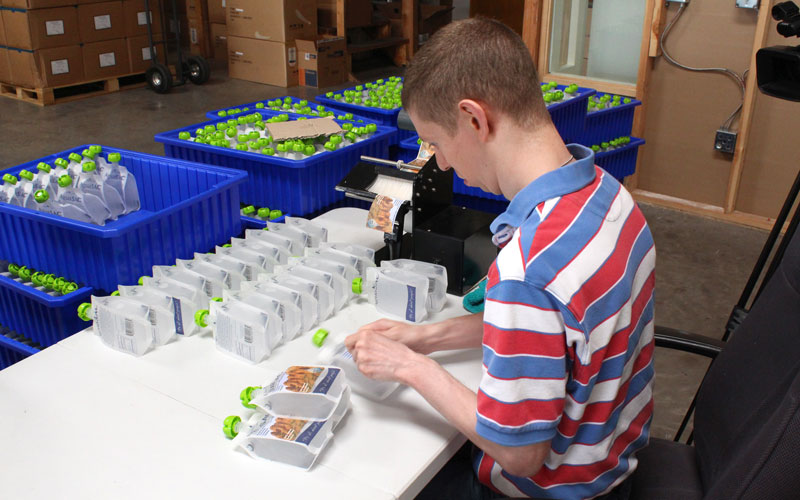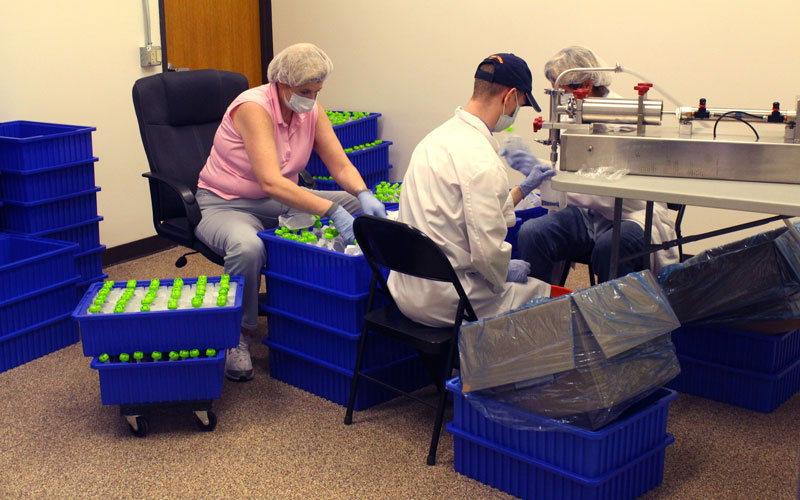
Andrew Lascurain works in production for AguaSac. An Arizona native, he has been there for more than a year, and is one of several people with diverse disabilities working there. (Photo by Mallory Price/Cronkite News)

The Arizona company packages drinking water from aquifers in Cave Creek into collapsible plastic bags designed to take up less space in landfills. (Photo by Mallory Price/Cronkite News)
Water rushes out of a spout in a small factory in north Phoenix as Andrew Lascurain holds a square plastic bags up to the nozzle.
“You are doing really well, buddy,” colleague Pattie Hovorka compliments him as the equipment buzzes.
Lascurain caps and places filled bags of water into blue plastic bins in a small “clean room.”
“I can see you smiling,” Hovorka said.
Lascurain works in production for AguaSac. The Arizona company packages drinking water from aquifers in Cave Creek into collapsible plastic bags designed to take up less space in landfills. The next step for Lascurain is to place labels and dates on the finished product.
Music fills the factory as Lascurain works. The 25-year-old smiles and laughs with Liesl Harder Kielp, AguaSac founder and chief executive, as he hands her labeled bags for her to stamp with the expiration date. “You see why I love coming to work,” she said.
Workers with disabilities have difficulties finding jobs
Lascurain was born with Williams Syndrome, which causes learning and developmental delays. Lascurain, an Arizona native who has been working for AguaSac for more than a year, is one of several people with diverse disabilities who work there. Some people who work at the factory have traumatic brain injuries, autism, mental illness and other intellectual disabilities.
People with intellectual and physical disabilities struggle to find employment across the U.S. and Arizona. Statistics on how many people with disabilities have jobs vary by source but reach the same conclusion that the employment rate for people with disabilities is significantly lower than those without disabilities.
A Cornell University study estimates nearly 35 percent of people with disabilities were employed in the U.S. in 2013. The Bureau of Labor Statistics put the full-time employment rate for people with disabilities at 17 percent in 2014, compared to nearly 65 percent of people without a disability having jobs.
People with disabilities are more likely to be 65 years of age or older, which partially accounts for the lower employment of people with disabilities. However, people with disabilities are less likely to work full time than those without a disability regardless of age, according to the labor bureau.
Workers and companies face challenges
Lascurain is a “superstar,” Harder Kielp said. “He knows how to do every job here.” His job is to fill AguaSacs with water and place labels and expiration dates on them. The 10-ounce pouches that he helps produce are available for a dollar at Sprouts stores in Arizona.
People with intellectual disabilities like Lascurain are underutilized in the workplace, but business owners and managers also need to understand such employees comes with unique challenges, Harder Kielp said. She had to adapt the work environment to fit the needs of her employees.
“When we first opened our doors here and started our own productions and we brought in a crew of individuals who had special needs, it completely annihilated our productivity,” Harder Kielp said. “That’s because we did not know what we were doing in respect to how to incorporate them into our corporation.”
Harder Kielp planned to primarily hire employees with intellectual disabilities when she opened in 2012 because she was concerned about the high unemployment rate. However, she found that it reduced the for-profit company’s efficiency. She now pairs a person with intellectual disabilities with a person who does not have a disability.
The buddy system creates an encouraging environment, she said. The company currently employs six people with disabilities and four people who do not have disabilities with plans to expand.
Lascurain likes the buddy system “because they give me a lot of confidence about what my future might be,” he said.
But people with intellectual disabilities face workplace struggles, including getting transportation to the job, completing work assignments and navigating social interactions with fellow employees. They can be bullied.
“It does not end in high school,” Harder Kielp said. She said it takes a team of people to protect the company and employees. She said Not all workplaces are not a good fit for people with intellectual disabilities because it “requires a very conscientious effort” to create the right work environment.
Diversity strengthens workplace, economy
People with disabilities who have jobs rely less on government help and bring diverse skills to the workplace.
More than 58 percent of people with disabilities received financial assistance through programs like Social Security Disability Income, Medicaid, and Medicare in 2012, according to the labor bureau. It said people with disabilities who work were less likely to receive financial assistance. Full time employment of people with disabilities helps to increase their independence, Harder Kielp said
The unemployment rate for workers with disabilities could be decreased if companies looked at the skills of an employee the individual and not rather than focus on their disability, Harder Kielp said.
It’s worth the effort, she said, because all employees have diverse talents , whether or not they have disabilities.
“People have different skill sets,” Harder Kielp said. Many people with intellectual disabilities are successful with repetitive work but some can do other work.
“We have a gentleman here that has autism and his social skills may be difficult to work with in that respect. His computer literacy is tremendous,” Harder Kielp said.
As the company expands, she wants employees to “move up the corporate ladder” into management.
“We have to open the door to corporate America and see where the opportunities exist,” said Harder Kielp said. “There is no reason why people with special needs can’t slide into a variety of areas.”
